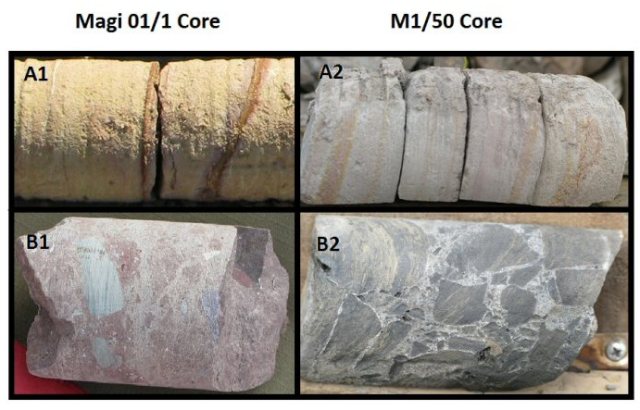May 16 2013
Pangolin Diamonds Corp. (the "Company" or "Pangolin") is pleased to announce it has discovered its first kimberlite at its 100% owned Tsabong North Project in Botswana. Core logging identified crater facies sediments and underlying reworked volcaniclastic kimberlite ("RVK") breccias in drill hole "Magi-01/1".
 These photos compare the various kimberlite crater facies sediments (A1, A2) and RVK breccias (B1, B2) from Pangolin's core drill hole Magi-01/1 (to the left) versus those from drill hole M1/50 from the M1 Kimberlite Pipe (to the right).
These photos compare the various kimberlite crater facies sediments (A1, A2) and RVK breccias (B1, B2) from Pangolin's core drill hole Magi-01/1 (to the left) versus those from drill hole M1/50 from the M1 Kimberlite Pipe (to the right).
Representative rock samples were submitted for independent whole rock analysis to Activation Laboratories Ltd., in Ancaster (Ontario). The results assisted in discriminating between the kimberlite crater facies sediments and the overlying Kalahari Formation. Crater facies sediments are present from a depth of 33.5 meters to 58.8 meters below which RVK breccia occurs to 76.3 meters. The crater facies sediments and RVK breccias intersected are consistent with the equivalent lithological units observed in the core of drill hole M1/50 from the M1 Kimberlite in the Tsabong Kimberlite Field which was drilled in 1981.
Dr Leon Daniels, B.Sc., Ph.D., Chairman of the Board of Pangolin, stated: "We are very pleased with Pangolin's success to date, as we have now graduated from an explorer to a discoverer and are determined to continue on this course."
The 45 mantle-derived indicator garnets, inclusive of some high pressure garnets previously announced on March 26, 2013, were liberated from a core sample in Magi-01/1 taken at a depth of 22 meters below the surface. A split of the available core will now be processed through a mini-Dense Media Separation Plant to recover any additional kimberlite indicator minerals, such as garnets, and/or macro diamonds from the kimberlite intersected section.
Based on these positive results, two additional diamond drill holes intersecting at least 100 meters of kimberlite will be drilled on the Magi-01 kimberlite for kimberlite indicator mineral and microdiamond recovery. The Company has also elevated additional previously identified kimberlite targets in the project area to targets of high immediate interest with similar magnetic signatures to Magi-01/1.
The photos in the link below compare the various kimberlite crater facies sediments (A1, A2) and RVK breccias (B1, B2) from Pangolin's core drill hole Magi-01/1 (to the left) versus those from drill hole M1/50 from the M1 Kimberlite Pipe (to the right).